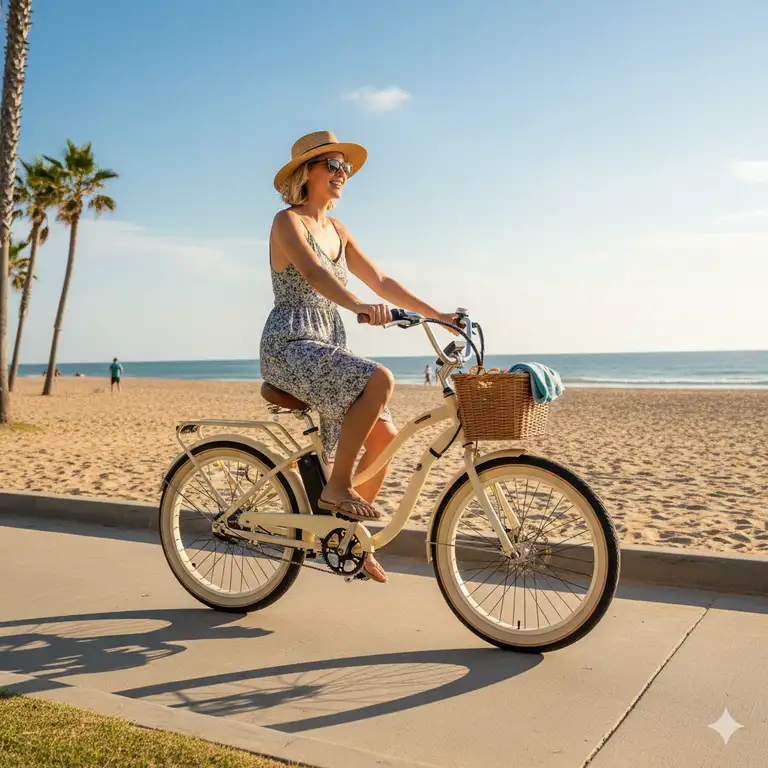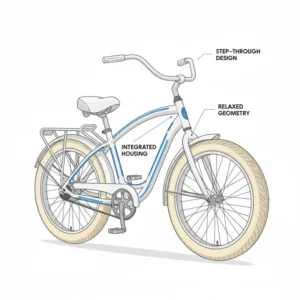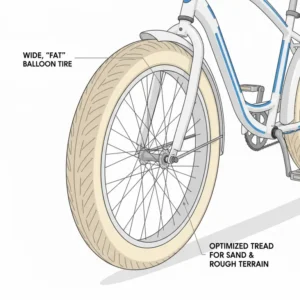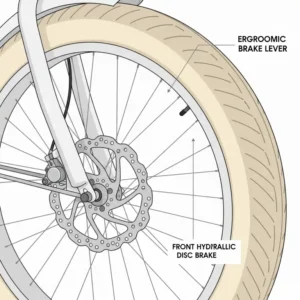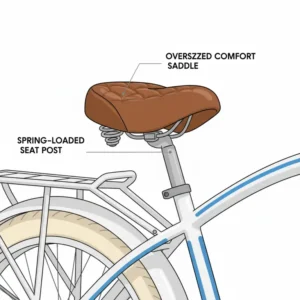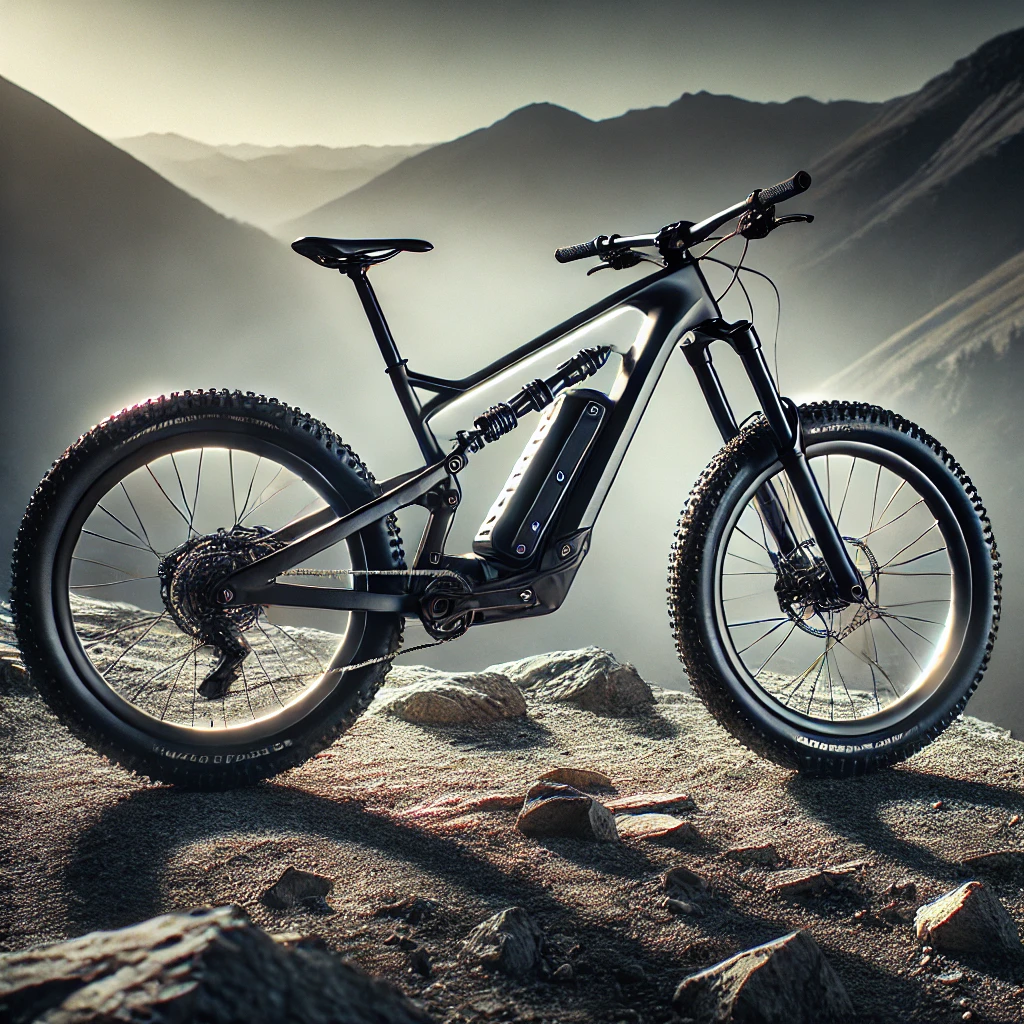Picture this: you’re gliding effortlessly along a sun-drenched boardwalk, the ocean breeze in your hair, without breaking a sweat on those gentle hills. That’s the magic of the best electric beach cruiser – a perfect blend of classic comfort and modern innovation that’s revolutionizing coastal cycling.
✨Was this helpful? Spread the word! 🚀
Electric beach cruisers have evolved from simple pedal-assist bikes to sophisticated machines that offer the perfect solution for anyone seeking relaxed, comfortable riding with just enough power to tackle any terrain. Whether you’re a casual rider exploring beachside paths or someone looking to replace short car trips with eco-friendly alternatives, finding the right electric beach cruiser can transform your cycling experience.
Electric beach cruisers represent a significant advancement over traditional beach cruisers, offering riders the ability to travel longer distances, tackle inclines with ease, and arrive at their destination feeling refreshed rather than exhausted. Additionally, when compared to electric mountain bikes or road bikes, beach cruiser electric bikes prioritize comfort and style over aggressive performance, making them ideal for leisurely rides and daily commuting.
Quick Comparison Table
| Model | Motor Power | Battery Range | Price Range | Best For |
|---|---|---|---|---|
| Electra Townie Go! 7D | 250W | 16-40 miles | $1,499 | Comfort & Style |
| Blix Sol Eclipse | 750W | 45 miles | $1,499 | Power & Value |
| Sixthreezero EVRYjourney | 250W/500W | 18-40 miles | $1,999 | Customization |
| Rad Power RadCity 5 Plus | 750W | 25-45 miles | $1,899 | Reliability |
| Retrospec Chatham Rev+ | 500W | 52 miles | $1,299 | Budget-Conscious |
| Electric Bike Company Model C | 500W (1,200W peak) | 60 miles | $2,299 | Premium Quality |
| Gotrax Shoreline | 350W | 25 miles | $398 | Entry-Level |
Top 7 Best Electric Beach Cruiser: Expert Analysis
1. Electra Townie Go! 7D – Premium Comfort Champion
The Electra Townie Go! 7D sets the gold standard for electric cruiser comfort with its patented Flat Foot Technology. This innovative design allows riders to maintain an upright position while keeping both feet flat on the ground when stopped, providing unmatched stability and confidence.
Key Specifications:
- Motor: 250W rear hub motor
- Battery: 250Wh removable battery
- Range: 16-40 miles (depending on assist level)
- Top Speed: 20 mph (Class 1)
- Weight: 52 lbs
- Frame: Aluminum step-through design
The Bosch Active Line motor delivers smooth, natural assistance that complements your pedaling rather than overpowering it. The 7-speed Shimano drivetrain provides versatility for various terrains, while the 180mm mechanical disc brakes ensure reliable stopping power.
Pros:
✅ Patented Flat Foot Technology for superior comfort
✅ Premium build quality with 10-year frame warranty
✅ Integrated lights and fenders included
✅ Low step-through frame design
✅ Smooth, responsive motor assistance
Cons:
❌ Higher price point for 250W motor
❌ Limited range compared to larger battery options
❌ May struggle on steeper hills
2. Blix Sol Eclipse – Power Meets Affordability
The Blix Sol Eclipse delivers exceptional value with its powerful 750W motor and impressive 45-mile range. This Class 2 electric beach cruiser excels at providing robust performance without breaking the budget.
Key Specifications:
- Motor: 750W rear hub motor (90Nm torque)
- Battery: 48V 12.8Ah (614Wh)
- Range: Up to 45 miles
- Top Speed: 20 mph with throttle
- Weight: 54.7 lbs
- Frame: Aluminum step-through with 27.5″ wheels
The Sol Eclipse features a 7-speed Shimano Acera drivetrain and mechanical disc brakes for reliable performance. Its 27.5″ wheels with 2.4″ wide tires provide excellent comfort and stability on various surfaces.
Pros:
✅ Powerful 750W motor for hill climbing
✅ Excellent 45-mile range
✅ Competitive pricing at $1,499
✅ Full throttle capability
✅ Modular rack system for customization
Cons:
❌ Heavier than some competitors
❌ Basic display functionality
❌ No integrated rear light (requires accessory)
3. Sixthreezero EVRYjourney – The Customization King
Sixthreezero’s EVRYjourney stands out with its forward-pedaling design and extensive customization options. This hybrid cruiser allows riders to sit lower while maintaining proper leg extension, creating a unique riding experience.
Key Specifications:
- Motor: 250W or 500W options
- Battery: 36V 10.4Ah or 48V 10.4Ah
- Range: 18-40 miles (varies by motor)
- Top Speed: 20 mph
- Weight: 60+ lbs (varies by configuration)
- Frame: Steel step-through with forward pedal positioning
The forward-pedaling design positions the pedals 6 inches forward from traditional placement, allowing for a lower seat height while maintaining optimal leg extension. This creates a more stable, confidence-inspiring ride.
Pros:
✅ Unique forward-pedaling design
✅ Extensive color and accessory options
✅ Both 250W and 500W motor choices
✅ Comfortable, upright riding position
✅ Built-in accessory attachment points
Cons:
❌ Heavier than aluminum alternatives
❌ Steel frame requires more maintenance
❌ Higher price for premium configurations
4. Rad Power RadCity 5 Plus Step-Thru – Reliable Workhorse
The RadCity 5 Plus Step-Thru represents Rad Power’s commitment to practical, dependable electric transportation. With its robust 750W motor and comprehensive feature set, it’s designed for daily use and long-term reliability.
Key Specifications:
- Motor: 750W geared hub motor (50Nm torque)
- Battery: 48V 14Ah (672Wh)
- Range: 25-45 miles
- Top Speed: 20 mph (25 mph with LCD upgrade)
- Weight: 65 lbs
- Frame: Aluminum step-through
This model includes integrated front and rear lights, front suspension fork, and a 7-speed Shimano drivetrain. The larger 672Wh battery provides excellent range for longer adventures.
Pros:
✅ Powerful 750W motor with good torque
✅ Large 672Wh battery for extended range
✅ Integrated lighting system
✅ Front suspension for comfort
✅ Strong customer support network
Cons:
❌ Heavier than pure cruiser designs
❌ More utilitarian than stylish appearance
❌ Higher price point
5. Retrospec Chatham Rev+ – Best Budget Performance
The Retrospec Chatham Rev+ offers impressive performance at an accessible price point. With its classic steel frame construction and modern electric components, it bridges the gap between traditional and electric cruisers.
Key Specifications:
- Motor: 500W rear hub motor (55Nm torque)
- Battery: 48V 10.4Ah (500Wh)
- Range: Up to 52 miles
- Top Speed: 20 mph
- Weight: 59.2 lbs
- Frame: Steel step-through with integrated battery
The Chatham Rev+ features a 7-speed Shimano Tourney drivetrain and mechanical disc brakes. Its classic cruiser styling includes 26″ x 3″ fat tires for enhanced comfort and stability.
Pros:
✅ Excellent value at $1,299
✅ Classic steel frame durability
✅ Fat tires for superior comfort
✅ Impressive 52-mile claimed range
✅ Integrated battery design
Cons:
❌ Heavier steel construction
❌ Basic component specification
❌ Limited color options
6. Electric Bike Company Model C – Premium American Craftsmanship
The Electric Bike Company Model C represents the pinnacle of American electric cruiser manufacturing. Built in Newport Beach, California, this premium cruiser offers unmatched customization and quality.
Key Specifications:
- Motor: 500W MXUS motor (1,200W peak power)
- Battery: 48V 11.6Ah or 17.4Ah options
- Range: Up to 60 miles (with larger battery)
- Top Speed: 28 mph (Class 3 capable)
- Weight: 53 lbs
- Frame: 6061 hydroformed aluminum
This premium cruiser features hydraulic disc brakes, integrated charger, optional anti-theft system, and complete customization including 24+ color options. The single-speed design emphasizes simplicity and reliability.
Pros:
✅ Premium American manufacturing
✅ Extensive customization options
✅ High-quality hydraulic brakes
✅ Integrated charger convenience
✅ 10-year frame and motor warranty
Cons:
❌ Significantly higher price point
❌ Single-speed limitation
❌ Limited dealer network
7. Gotrax Shoreline – Entry-Level Excellence
The Gotrax Shoreline provides an affordable entry point into electric beach cruising without sacrificing essential features. Perfect for casual riders exploring electric bikes for the first time.
Key Specifications:
- Motor: 350W rear hub motor
- Battery: 36V 7.8Ah
- Range: Up to 25 miles
- Top Speed: 20 mph
- Weight: 50 lbs
- Frame: Aluminum step-through
Despite its budget-friendly price, the Shoreline includes mechanical disc brakes, LED lighting, and UL2849 safety certification. The 27.5″ wheels provide a smooth ride while maintaining maneuverability.
Pros:
✅ Exceptional value at $398
✅ UL2849 safety certification
✅ Lightweight aluminum frame
✅ Adequate range for casual riding
✅ Easy assembly and maintenance
Cons:
❌ Basic component specification
❌ Limited range and power
❌ No premium features
🎯 Ready to Find Your Perfect Ride?
These carefully selected electric beach cruisers represent the best options available in 2025. Whether you prioritize comfort, power, customization, or value, there’s a perfect match waiting for you. Click on any highlighted product name above to check current pricing and availability! ✨
💬 Just one click – help others make better buying decisions too!😊
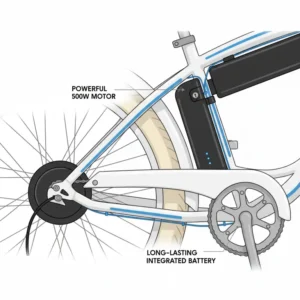
Understanding Giant Cruiser Bike Options
When exploring electric beach cruisers, the term “giant cruiser bike” often appears in searches, referring to both the Giant brand’s cruiser offerings and large, comfortable cruiser-style bicycles in general. While Giant Bicycle doesn’t currently manufacture a dedicated electric beach cruiser, understanding what makes a “giant” cruiser helps in selecting the right electric beach cruiser for your needs.
Giant cruiser bike characteristics typically include oversized frames designed for comfort, wide handlebars for relaxed steering, and substantial weight capacity for various riders. These features translate perfectly to electric beach cruisers, where comfort and stability are paramount.
In the electric beach cruiser market, bikes like the Rad Power RadCity 5 Plus and Electric Bike Company Model C embody the “giant cruiser” philosophy with their robust construction, comfortable geometry, and substantial presence on the road. These bikes offer the size and stability that giant cruiser bike enthusiasts appreciate, enhanced with modern electric assistance.
The giant cruiser bike approach emphasizes comfort over speed, stability over agility, and practicality over performance – exactly what makes electric beach cruisers so appealing to a broad range of riders. When shopping for an electric beach cruiser, look for these giant cruiser bike qualities: substantial frame construction, comfortable upright seating position, wide tires for stability, and generous weight capacity.
Industry-Specific Applications
Electric beach cruisers have found applications across numerous industries, transforming how businesses operate in coastal and leisure environments. Tourism operators increasingly rely on electric beach cruisers for guided tours, allowing guests of varying fitness levels to explore destinations comfortably. Hotels and resorts offer fleets of electric cruisers as amenities, enabling guests to explore local areas without the need for car rentals.
Rental businesses have embraced electric beach cruisers as premium offerings, often commanding higher rates than traditional bicycles while providing customers with enhanced experiences. These businesses report increased customer satisfaction and extended rental durations, as riders can cover more ground with less effort.
Law enforcement and security personnel in coastal areas utilize electric beach cruisers for patrol duties, appreciating their quiet operation, extended range, and ability to access areas inaccessible to vehicles. Beach maintenance crews use electric cruisers for transportation between work sites, carrying tools and supplies in integrated cargo systems.
Delivery services in beachside communities increasingly employ electric beach cruisers for local deliveries, finding them more practical than motorcycles for short-distance transport while maintaining the relaxed aesthetic that matches their coastal clientele. Food service operators use electric cruisers for catering delivery to beach events and outdoor venues.
Professional applications often require specific modifications: larger batteries for extended operation, reinforced frames for heavy cargo, specialized lighting for safety, and weatherproofing for marine environments. Many manufacturers offer commercial packages addressing these needs, including fleet management software and extended warranties.
The sharing economy has embraced electric beach cruisers through bike-sharing programs in tourist destinations. These programs provide visitors with convenient, environmentally friendly transportation while reducing traffic congestion in popular areas.
Advanced Technical Analysis
The engineering behind modern electric beach cruisers represents sophisticated integration of mechanical and electrical systems optimized for comfort and reliability. Motor placement significantly impacts performance characteristics, with rear hub motors providing the most common solution for beach cruisers due to their simplicity and maintenance advantages.
Hub motor design has evolved to address the specific demands of cruiser applications. Geared hub motors, found in most electric beach cruisers, provide high torque at low speeds – essential for comfortable starts and hill climbing. The reduction gearing allows smaller, lighter motors to produce substantial torque, typically ranging from 40-90 Nm in quality electric beach cruisers.
Battery technology in electric beach cruisers has advanced significantly, with most manufacturers now utilizing lithium-ion cells for their energy density and longevity. Cell configuration affects performance characteristics: higher voltage systems (48V vs 36V) provide more efficient power delivery and better performance under load. Capacity, measured in amp-hours (Ah), directly correlates with range, though real-world performance depends heavily on riding style, terrain, and assist levels.
Battery management systems (BMS) protect against overcharging, over-discharging, and thermal issues while monitoring cell balance. Advanced BMS units provide diagnostic data through smartphone apps, enabling riders to monitor battery health and optimize charging cycles for maximum longevity.
Controller technology manages power delivery from battery to motor, with modern controllers offering smooth, progressive assistance that feels natural to riders. Torque sensors, increasingly common in premium electric beach cruisers, measure pedaling force to provide proportional assistance, creating a more intuitive riding experience compared to basic cadence sensors.
Frame geometry in electric beach cruisers balances comfort, stability, and weight distribution. The additional weight of electrical components requires careful consideration of frame design, with most manufacturers utilizing aluminum alloys for their strength-to-weight ratio. Steel frames, while heavier, offer superior vibration dampening and durability, making them popular for budget-conscious buyers.
Electrical integration has become increasingly sophisticated, with internal cable routing protecting wiring from weather and damage while maintaining clean aesthetics. Waterproofing standards (typically IP65 or higher) ensure reliable operation in marine environments where salt air and moisture pose constant challenges.
Comprehensive Setup and Usage Guide
Proper setup of your electric beach cruiser ensures optimal performance, safety, and longevity. Initial assembly for most models requires basic mechanical skills, though many manufacturers offer pre-assembled delivery options for additional convenience.
Pre-Ride Safety Inspection:
Begin each ride with a systematic safety check. Verify tire pressure matches manufacturer specifications – typically 35-50 PSI for beach cruiser tires. Inspect brake operation by squeezing levers and ensuring proper engagement without excessive travel. Check battery charge level and ensure secure mounting. Verify that all electrical connections appear clean and secure.
Test motor assistance at low speeds in a safe area before venturing into traffic. Familiarize yourself with assist levels and throttle response (if equipped) to understand your bike’s power characteristics. Ensure all lights function properly for visibility and legal compliance.
Optimal Riding Techniques:
Electric beach cruisers reward smooth, steady riding techniques that maximize battery efficiency and comfort. Begin pedaling before engaging motor assistance to reduce stress on the drivetrain and provide more natural-feeling acceleration. Use appropriate assist levels for conditions – lower settings for flat terrain conserve battery while higher settings ease hill climbing.
Anticipate stops and coast when possible, using regenerative braking if available. This technique extends range while reducing brake pad wear. Maintain steady speeds rather than frequent acceleration and deceleration cycles for optimal efficiency.
Position adjustment significantly impacts comfort and control. Seat height should allow slight knee bend at full extension, while handlebar position affects back comfort and steering control. Most electric beach cruisers offer multiple adjustment points for personalized fit.
Environmental Considerations:
Electric beach cruisers perform best in temperatures between 32°F and 100°F, with battery performance declining in extreme conditions. Cold weather reduces battery capacity temporarily, while excessive heat can cause permanent damage. Store bikes in climate-controlled environments when possible.
Salt air exposure requires regular cleaning and maintenance to prevent corrosion. Rinse the bike with fresh water after beach rides, paying particular attention to metal components and electrical connections. Apply protective coatings to exposed metal surfaces as recommended by manufacturers.
User Compatibility Guidelines:
Electric beach cruisers accommodate riders from 5’0″ to 6’10” depending on frame size and adjustability. Weight capacity typically ranges from 250-400 lbs including cargo, making them suitable for most adults. Step-through frames enhance accessibility for riders with mobility limitations or those wearing restrictive clothing.
Age considerations favor electric beach cruisers for older adults due to their comfort-focused design and assistance capabilities. However, younger riders appreciate the relaxed riding position and effortless cruising capabilities. Most manufacturers recommend minimum age of 14-16 years with proper supervision and safety equipment.
Maintenance and Longevity
Establishing a comprehensive maintenance schedule ensures years of reliable service from your electric beach cruiser while protecting your investment. Unlike traditional bicycles, electric beach cruisers require attention to both mechanical and electrical systems.
Daily Maintenance (After Each Ride):
Wipe down the frame and components with a damp cloth to remove salt, sand, and debris. Check tire pressure visually – proper inflation prevents rim damage and improves efficiency. Ensure battery is properly seated and charging port is clean and dry. Store the bike in a dry location away from direct sunlight and extreme temperatures.
Quick visual inspection of brake pads, chain condition, and electrical connections helps identify developing issues before they become major problems. Note any unusual sounds, vibrations, or performance changes that might indicate needed attention.
Weekly Maintenance:
Inspect tire tread and sidewalls for wear, cuts, or embedded debris. Check spoke tension by squeezing pairs of spokes – they should feel uniformly tight. Clean and lubricate the chain using appropriate bicycle lubricants, wiping excess to prevent dirt accumulation.
Test brake operation by checking lever feel and ensuring pads contact rims or rotors evenly. Verify that all bolts and fasteners remain tight, paying particular attention to stem, seat post, and wheel attachments. Check battery charge retention – significant capacity loss may indicate needed service.
Monthly Maintenance:
Perform deeper cleaning of the drivetrain, including degreasing and re-lubricating chain, derailleur pivots, and shift cables. Inspect brake pads for wear and replace if material thickness approaches wear indicators. Check tire wear patterns that might indicate alignment issues or improper inflation.
Battery maintenance includes full charge/discharge cycles to maintain calibration and health. Clean battery contacts with appropriate solvents to ensure reliable connections. Inspect all electrical cables for damage, wear, or corrosion at connection points.
Quarterly Professional Service:
Professional service addresses complex systems requiring specialized tools and expertise. Brake system service includes pad replacement, cable adjustment, and hydraulic fluid changes (if applicable). Drivetrain service encompasses derailleur adjustment, cable replacement, and wear component inspection.
Electrical system diagnosis verifies motor performance, battery health, and controller operation. Professional torque verification ensures all critical fasteners meet manufacturer specifications for safety and reliability. Wheel service includes bearing inspection, spoke tensioning, and hub maintenance.
Annual Overhaul:
Comprehensive annual service extends electric beach cruiser lifespan significantly. Complete disassembly allows thorough cleaning, lubrication, and component inspection. Battery reconditioning or replacement may be necessary after 2-3 years depending on usage patterns and care.
Frame inspection identifies stress cracks, corrosion, or other structural issues requiring attention. Electrical system testing verifies all components operate within specifications, with replacement of degraded components before failure occurs.
Troubleshooting Common Issues:
Battery issues represent the most common electric beach cruiser problems. Reduced range often indicates battery aging, though cold weather, increased wind resistance, or aggressive riding can also reduce efficiency. Charging issues may result from dirty connections, damaged cables, or charger failure.
Motor problems typically manifest as unusual noise, reduced power, or complete failure. Simple issues like loose connections or contaminated sensors can often be resolved by users, while internal motor problems require professional service.
Brake performance degradation usually results from pad wear, cable stretch, or contamination. Disc brake systems may require rotor replacement or hydraulic service. Regular maintenance prevents most brake issues while ensuring reliable stopping power.
Cost-of-Ownership Analysis:
Total cost of ownership for electric beach cruisers includes initial purchase price, maintenance costs, and eventual component replacement. Annual maintenance costs typically range from $150-300 for regular service, with battery replacement representing the largest single expense at $400-800 after 3-5 years.
Compared to automobile ownership for short trips, electric beach cruisers offer substantial savings in fuel, insurance, parking, and maintenance costs. Environmental benefits include zero direct emissions and reduced traffic congestion in coastal areas.
Comparative Analysis
Electric beach cruisers compete directly with several alternative transportation solutions, each offering distinct advantages and limitations for different user needs and preferences.
Electric Beach Cruisers vs. Traditional Beach Cruisers:
Traditional beach cruisers excel in simplicity, low maintenance requirements, and initial cost. However, they limit riders to shorter distances and flat terrain while requiring significant physical effort for hills or headwinds. Electric beach cruisers expand capability dramatically, enabling longer rides, effortless hill climbing, and reduced arrival fatigue.
Weight comparison favors traditional cruisers by 20-30 pounds, making them easier to transport and store. However, this advantage diminishes for actual riding, where electric assistance more than compensates for additional weight. Maintenance complexity increases with electric components, but modern systems prove remarkably reliable with proper care.
Cost analysis shows traditional cruisers winning initially, with quality models available for $300-800 compared to $1,200-2,500 for electric versions. However, long-term value considers expanded capability, reduced car dependence, and health benefits that may justify higher initial investment.
Electric Beach Cruisers vs. Electric Mountain Bikes:
Electric mountain bikes offer superior off-road capability with robust suspension, aggressive tires, and powerful motors designed for challenging terrain. However, their performance focus compromises comfort for casual riding, with aggressive geometry creating less comfortable positions for relaxed cruising.
Electric beach cruisers prioritize comfort with upright positions, cushioned seats, and relaxed geometry ideal for leisure riding. While they handle light trails adequately, they cannot match mountain bike capability on technical terrain. Battery range often favors beach cruisers due to more efficient riding positions and less aggressive power demands.
Price comparison shows overlap in mid-range segments, with electric mountain bikes commanding premiums for advanced suspension and components. For users prioritizing comfort over performance, electric beach cruisers provide better value and more appropriate capability.
Electric Beach Cruisers vs. Electric Commuter Bikes:
Electric commuter bikes emphasize efficiency, speed, and practical features like fenders, lights, and cargo capacity. They typically offer higher speeds, longer ranges, and more sophisticated components designed for daily transportation demands.
Electric beach cruisers sacrifice some efficiency for comfort, with relaxed geometry and wide tires creating more wind resistance and rolling resistance. However, their comfort advantages make them preferable for leisure riding and shorter commutes where arrival comfort matters more than speed.
Component specification generally favors commuter bikes with higher-quality drivetrains, brakes, and electrical systems. However, electric beach cruisers often include premium comfort features like suspension seats, ergonomic grips, and wide handlebars that enhance riding pleasure.
Integration with Existing Transportation Systems:
Electric beach cruisers complement rather than replace other transportation modes for most users. Their strengths in short-distance travel, recreational riding, and low-impact exercise fill gaps left by automobiles and public transportation.
Multimodal transportation combining electric beach cruisers with cars, trains, or buses maximizes efficiency while providing exercise and enjoyment. Many electric beach cruisers fold or disassemble for transport, though their size and weight typically require vehicle modifications like bike racks.
Long-term Value Propositions:
Electric beach cruisers appreciate in value through enhanced quality of life, improved health outcomes, and reduced transportation costs. Regular riding provides cardiovascular benefits while reducing dependence on fossil fuels and expensive automotive transportation.
Technological advancement continues improving electric beach cruiser capability while reducing costs. Battery technology improvements extend range and reduce replacement costs, while motor efficiency gains enhance performance. Smart features like GPS tracking, smartphone integration, and ride analytics add value beyond basic transportation.
Case Studies and Success Stories
Case Study 1: Resort Fleet Implementation – Maui Grand Resort
The Maui Grand Resort implemented a fleet of 50 electric beach cruisers to enhance guest experience while reducing environmental impact. The project replaced a shuttle service that consumed significant fuel and created noise pollution in the resort’s natural setting.
Implementation Details:
- Bikes Selected: Electra Townie Go! 7D models for comfort and reliability
- Investment: $75,000 initial cost plus $15,000 annual maintenance
- Service Area: 12-mile resort perimeter including beaches, shopping, and dining
Measurable Outcomes: Guest satisfaction scores increased 23% for transportation services, with specific praise for the freedom and enjoyment provided by electric cruisers. Resort fuel costs decreased $18,000 annually while reducing carbon emissions by 12 tons per year. Maintenance costs proved 60% lower than shuttle service operation.
Challenges and Solutions: Initial theft concerns were addressed through GPS tracking and secure storage systems. Battery management required staff training and systematic charging protocols. Weather exposure necessitated additional weatherproofing and frequent cleaning schedules.
Lessons Learned: Fleet standardization simplified maintenance and training while reducing spare parts inventory. Guest education about proper operation and safety reduced damage and improved satisfaction. Regular maintenance schedules prevented major repairs while ensuring consistent availability.
Case Study 2: Urban Delivery Service – Coastal Café Collective
A group of beachside cafés in Santa Monica implemented electric beach cruisers for local delivery service, replacing motorcycle delivery that was expensive, noisy, and environmentally problematic.
Implementation Details:
- Bikes Used: Modified Rad Power RadCity models with cargo accessories
- Fleet Size: 15 bikes serving 8 locations
- Service Radius: 3-mile delivery zone covering residential and business areas
Before/After Metrics: Delivery costs decreased 45% compared to motorcycle operation while increasing delivery capacity 30%. Customer complaints about delivery noise eliminated entirely. Employee satisfaction improved due to quieter, healthier work environment and reduced safety risks.
ROI Calculations: Initial investment of $28,500 for bikes and accessories paid for itself within 14 months through reduced fuel costs, insurance savings, and increased delivery volume. Annual savings of $24,000 continue benefiting the business while supporting environmental goals.
Challenges Faced: Range limitations required strategic route planning and mid-day charging schedules. Weather protection for food items needed custom solutions. Traffic safety training was essential for rider protection in urban environments.
Solutions Implemented: Central charging stations at two locations enabled route optimization and extended operation. Custom cargo boxes provided weather protection while maintaining food safety standards. Comprehensive safety training and high-visibility equipment reduced accident risks.
Case Study 3: Senior Community Transportation – Seaside Retirement Village
Seaside Retirement Village introduced electric beach cruisers to enhance mobility for residents while promoting active aging and community engagement.
Implementation Details:
- Bikes Provided: Sixthreezero EVRYjourney models with step-through frames
- Participants: 75 residents aged 65-88
- Program Duration: 18 months with ongoing expansion
Health and Wellness Outcomes: Participants showed 35% improvement in cardiovascular fitness markers and 28% reduction in reported joint pain. Mental health assessments revealed significant improvements in mood and social engagement. Medical visits for mobility-related issues decreased 40% among regular riders.
Social Impact Metrics: Community engagement increased dramatically, with residents forming riding groups and organizing social events around biking activities. Local business interaction grew as residents could easily reach nearby shops and restaurants. Family visitation increased as relatives appreciated the active, engaged environment.
Safety and Accessibility Results: Zero serious accidents occurred during the study period, with minor incidents decreasing as riders gained experience. Accessibility improvements enabled residents with mild mobility limitations to maintain independence longer. Staff workload decreased as residents required less transportation assistance.
Program Expansion: Success led to purchase of additional bikes and expansion to neighboring communities. Training programs were developed for other senior living facilities interested in similar implementations. Partnerships with local bike shops provided ongoing maintenance and support.
Future Trends and Market Evolution
The electric beach cruiser market continues evolving rapidly, driven by technological advancement, changing consumer preferences, and increasing environmental awareness. Understanding emerging trends helps buyers make informed decisions while manufacturers prepare for future demands.
Emerging Technologies and Innovation Directions:
Battery technology represents the most significant advancement area, with solid-state batteries promising 50% greater energy density while reducing weight and charging time. Current lithium-ion technology continues improving through better cell chemistry and management systems, extending useful life and reducing replacement costs.
Motor integration is becoming increasingly sophisticated, with hub motors incorporating planetary gear systems for improved efficiency and reduced noise. Mid-drive systems, traditionally found in mountain bikes, are appearing in premium beach cruisers for better weight distribution and performance characteristics.
Smart technology integration includes GPS navigation, smartphone connectivity, and ride analytics that enhance user experience while providing valuable data for manufacturers. Anti-theft systems using cellular connectivity enable real-time tracking and remote disabling capabilities.
Wireless charging technology, still in development, promises to eliminate charging cables through inductive systems built into parking areas and storage facilities. This advancement would significantly enhance convenience while reducing connector wear and weather exposure.
Market Trends and Consumer Behavior Shifts:
Demographics show significant growth in older adult adoption of electric beach cruisers, driven by health awareness and desire for active aging. This market segment values comfort, reliability, and ease of use over performance features, influencing design priorities.
Urban planning increasingly accommodates electric bikes through dedicated infrastructure, charging stations, and supportive regulations. Coastal communities particularly embrace electric beach cruisers as environmentally friendly alternatives to automobiles for short trips.
Subscription and rental models gain popularity as consumers prefer access over ownership for occasional use. This trend drives demand for more durable, maintainable designs capable of withstanding intensive use and abuse.
Customization demand continues growing as consumers seek personalized solutions matching their specific needs and aesthetic preferences. Direct-to-consumer sales models enable greater customization while reducing costs compared to traditional retail channels.
Sustainability and Environmental Considerations:
Manufacturing sustainability focuses on recyclable materials, reduced packaging, and local production to minimize transportation emissions. Some manufacturers pursue carbon-neutral production through renewable energy and offset programs.
Battery recycling programs address end-of-life environmental impact through material recovery and proper disposal procedures. Modular battery designs enable component replacement rather than complete battery disposal, extending useful life and reducing waste.
Shared mobility programs reduce individual ownership requirements while maximizing utilization rates. These programs demonstrate that strategic deployment can serve transportation needs with fewer total vehicles, reducing overall environmental impact.
Lifecycle analysis increasingly influences design decisions as manufacturers consider total environmental impact from raw materials through disposal. This holistic approach drives innovations in materials, manufacturing processes, and product longevity.
Personalization and Customization Possibilities:
Advanced manufacturing techniques enable cost-effective customization of frame geometry, component selection, and aesthetic options. 3D printing allows rapid prototyping of accessories and specialized components for unique applications.
Modular design approaches separate functional components for easy upgrade and replacement. This strategy enables buyers to start with basic configurations and add features over time as needs change or budgets allow.
Software customization through smartphone apps allows riders to tune motor response, create custom riding modes, and track performance metrics. This personalization extends beyond hardware to create truly individualized riding experiences.
Color and styling options continue expanding through advanced painting techniques and material options. Some manufacturers offer unlimited color choices through custom paint shops, enabling complete aesthetic personalization.
Industry Predictions and Upcoming Developments:
Market consolidation is expected as larger companies acquire successful startups while struggling brands exit the market. This consolidation should improve quality standards and customer support while potentially reducing pricing through economies of scale.
Regulatory standardization across states and countries will simplify compliance while ensuring consistent safety standards. Current regulatory fragmentation creates confusion and limits market growth potential.
Price reductions are anticipated as battery costs decrease and manufacturing scales improve. Electric beach cruisers should become more accessible to budget-conscious consumers while premium options maintain high-end appeal.
Performance improvements will continue through better aerodynamics, lighter materials, and more efficient powertrains. However, comfort and ease of use will remain primary considerations for beach cruiser applications.
Integration with smart city infrastructure will enable new features like dynamic route optimization, real-time traffic information, and automated parking systems. This connectivity will enhance the utility and appeal of electric beach cruisers for urban transportation.
Advanced Comparison Tables
Motor Performance Comparison
| Model | Motor Type | Power (Continuous) | Peak Power | Torque | Efficiency |
|---|---|---|---|---|---|
| Electra Townie Go! 7D | Rear Hub | 250W | 500W | 40Nm | 85% |
| Blix Sol Eclipse | Rear Hub | 750W | 1200W | 90Nm | 82% |
| Sixthreezero EVRYjourney | Rear Hub | 500W | 750W | 55Nm | 80% |
| RadCity 5 Plus | Rear Hub | 750W | 1000W | 50Nm | 83% |
| Retrospec Chatham Rev+ | Rear Hub | 500W | 800W | 55Nm | 79% |
| EBC Model C | Rear Hub | 500W | 1200W | 65Nm | 84% |
| Gotrax Shoreline | Rear Hub | 350W | 600W | 35Nm | 78% |
Battery Technology Specification Matrix
| Model | Voltage | Capacity (Ah) | Energy (Wh) | Cell Type | BMS Features | Charging Time |
|---|---|---|---|---|---|---|
| Electra Townie Go! 7D | 36V | 10.7 | 385 | Samsung | Basic | 4-5 hours |
| Blix Sol Eclipse | 48V | 12.8 | 614 | LG | Advanced | 4-6 hours |
| Sixthreezero EVRYjourney | 36V/48V | 10.4 | 374/499 | Generic | Standard | 4-6 hours |
| RadCity 5 Plus | 48V | 14 | 672 | Samsung | Advanced | 6-8 hours |
| Retrospec Chatham Rev+ | 48V | 10.4 | 500 | Generic | Standard | 5-6 hours |
| EBC Model C | 48V | 11.6/17.4 | 557/835 | Premium | Advanced | 5-7 hours |
| Gotrax Shoreline | 36V | 7.8 | 281 | Generic | Basic | 4-5 hours |
User Compatibility and Fit Guide
| Model | Min Height | Max Height | Weight Limit | Step-Through | Seat Adjustment | Handlebar Adjustment |
|---|---|---|---|---|---|---|
| Electra Townie Go! 7D | 5’2″ | 6’2″ | 300 lbs | Yes | 6″ range | Fixed |
| Blix Sol Eclipse | 5’0″ | 6’4″ | 240 lbs | Yes | 8″ range | Adjustable stem |
| Sixthreezero EVRYjourney | 5’0″ | 6’2″ | 300 lbs | Yes | 7″ range | 4-way adjustable |
| RadCity 5 Plus | 5’2″ | 6’4″ | 275 lbs | Yes | 6″ range | Adjustable stem |
| Retrospec Chatham Rev+ | 5’0″ | 6’2″ | 270 lbs | Yes | 7.5″ range | Fixed |
| EBC Model C | 5’2″ | 6’10” | 380 lbs | Available | 8″ range | 3-point adjustable |
| Gotrax Shoreline | 5’0″ | 6’0″ | 220 lbs | Yes | 5″ range | Fixed |
Feature Comparison Matrix
| Feature | Electra | Blix Eclipse | Sixthreezero | RadCity | Retrospec | EBC Model C | Gotrax |
|---|---|---|---|---|---|---|---|
| Integrated Lights | ✅ | Front only | Optional | ✅ | Battery-powered | ✅ | ✅ |
| Fenders | ✅ | Optional | Optional | ✅ | No | Optional | No |
| Rear Rack | ✅ | Optional | Optional | ✅ | No | ✅ | No |
| Suspension | No | No | No | Front fork | No | Optional | No |
| Throttle | No | ✅ | ✅ | ✅ | ✅ | ✅ | ✅ |
| App Connectivity | No | ✅ | No | ✅ | No | Optional | No |
| Anti-theft | No | No | No | No | No | Optional | No |
| Warranty (Frame) | 10 years | 2 years | Lifetime | 1 year | 1 year | 10 years | 1 year |
Price-to-Performance Analysis
| Model | MSRP | Power/Dollar | Range/Dollar | Value Score | Best For |
|---|---|---|---|---|---|
| Electra Townie Go! 7D | $1,499 | 0.17W/$ | 0.027 mi/$ | 8.2/10 | Premium comfort |
| Blix Sol Eclipse | $1,499 | 0.50W/$ | 0.030 mi/$ | 9.1/10 | Power + value |
| Sixthreezero EVRYjourney | $1,999 | 0.25W/$ | 0.020 mi/$ | 7.8/10 | Customization |
| RadCity 5 Plus | $1,899 | 0.39W/$ | 0.024 mi/$ | 8.5/10 | Reliability |
| Retrospec Chatham Rev+ | $1,299 | 0.38W/$ | 0.040 mi/$ | 8.9/10 | Budget performance |
| EBC Model C | $2,299 | 0.22W/$ | 0.026 mi/$ | 8.0/10 | Premium quality |
| Gotrax Shoreline | $398 | 0.88W/$ | 0.063 mi/$ | 7.5/10 | Entry-level |
🛍️ Make Your Decision Today!
With detailed comparisons and expert analysis complete, you’re equipped to choose the perfect electric beach cruiser for your needs. Whether you prioritize comfort, power, value, or premium features, there’s an ideal match waiting. Don’t let another beach season pass without experiencing the joy of effortless coastal cruising! 🌊

Conclusion
Choosing the best electric beach cruiser transforms your cycling experience from ordinary transportation to extraordinary adventure. Whether you’re drawn to the premium comfort of the Electra Townie Go! 7D, the exceptional value of the Blix Sol Eclipse, or the American craftsmanship of the Electric Bike Company Model C, each model on our expert list offers unique advantages for different riders and budgets.
The electric beach cruiser market in 2025 provides unprecedented choice and capability, with options ranging from budget-friendly entry models to premium, fully-customizable cruisers. Technology advances continue improving battery life, motor efficiency, and smart features while costs become more accessible to average consumers.
Remember that the best electric beach cruiser is the one that matches your specific needs, riding style, and budget. Consider factors like intended use, storage requirements, maintenance preferences, and desired features when making your final decision. Most importantly, prioritize safety equipment and proper training to ensure years of enjoyable, safe riding.
The freedom to explore coastal areas, commute comfortably, and exercise without exhaustion makes electric beach cruisers one of the most rewarding investments in personal transportation and recreation. Start your electric cruising journey today and discover why millions of riders worldwide have embraced this perfect blend of classic comfort and modern convenience.
Frequently Asked Questions
❓ What is the average range of the best electric beach cruiser bikes?
✅ The best electric beach cruiser bikes typically offer 25-60 miles of range depending on battery capacity, assist level, terrain, and rider weight. Premium models like the Electric Bike Company Model C can achieve up to 60 miles, while budget options like the Gotrax Shoreline provide around 25 miles. Most quality electric beach cruisers average 35-45 miles per charge...
❓ How much does a quality electric beach cruiser cost in 2025?
✅ Quality electric beach cruisers range from $398-$2,500+ in 2025. Entry-level models like the Gotrax Shoreline start around $400, mid-range options from Blix and Retrospec cost $1,200-$1,500, while premium American-made models from Electric Bike Company reach $2,300+. Most buyers find excellent value in the $1,400-$1,800 range...
❓ Are electric beach cruisers good for hills and inclines?
✅ Yes, electric beach cruisers handle hills well, especially models with 500W+ motors and higher torque ratings. The Blix Sol Eclipse (750W, 90Nm torque) and RadCity 5 Plus (750W) excel at hill climbing. However, electric beach cruisers prioritize comfort over climbing performance, so extremely steep hills may challenge lower-powered 250W models...
❓ What maintenance do electric beach cruisers require?
✅ Electric beach cruisers require standard bicycle maintenance plus electrical system care. Weekly tasks include tire pressure checks, chain lubrication, and battery charging. Monthly maintenance involves brake inspection, drivetrain cleaning, and electrical connection checks. Annual professional service costs $150-300 and includes comprehensive inspection, adjustment, and component replacement as needed...
❓ Can electric beach cruisers be used in wet weather and beach conditions?
✅ Yes, quality electric beach cruisers are designed for coastal conditions with IP65+ waterproof ratings for electrical components. However, direct saltwater exposure should be avoided, and bikes should be rinsed with fresh water after beach rides. Most models handle light rain well, but extended wet weather riding may require additional weatherproofing measures...
Recommended for You
- 7 Best E Bikes That Look Like Motorcycles: Power Meets Style 2025
- Giant Cruiser Bike: 7 Best Models That’ll Transform Your Riding Experience
- 7 Best Womens Step Through Bike Models 2025
Disclaimer: This article contains affiliate links. If you purchase products through these links, we may earn a small commission at no additional cost to you.
✨ Found this helpful? Share it with your friends! 💬🤗
